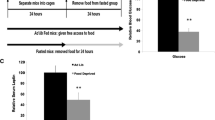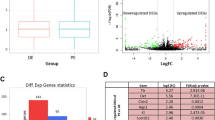Abstract
Gut microbiota can affect multiple brain functions and cause behavioral alterations through the microbiota-gut-brain axis. In our previous study, we found that the absence of gut microbiota can influence the expression of microRNAs and mRNAs in the hippocampal region of the germ-free (GF) mice. Long non-coding RNAs (lncRNAs) are increasingly being recognized as an important functional transcriptional regulator in the brain. In the present study, we aim to identify possible biological pathways and functional networks for lncRNA-associated transcript of the gut microbiota in relation to the brain function. The profiles of lncRNA and mRNA from specific pathogen-free (SPF), colonized GF (CGF), and GF mice were generated using the Agilent Mouse LncRNA Array v2.0. Differentially expressed (DE) lncRNAs and mRNAs were identified, and lncRNA target genes were also predicted. Ingenuity pathway analysis (IPA) was performed to analyze related signaling pathways and biological functions associated with these dysregulated mRNAs and target genes. Validation with quantitative real-time PCR was performed on several key genes. Compared with SPF mice a total of 2230 DE lncRNAs were found in GF mice. Among these, 1355 were upregulated and 875 were downregulated. After comparing the target genes of DE lncRNAs with mRNA datasets, 669 overlapping genes were identified. IPA core analyses revealed that most of these genes were highly associated with cardiac hypertrophy, nuclear factors of activated T cells (NFAT) gonadotropin-releasing hormone (GnRH), calcium, and cAMP-response element-binding protein (CREB) signaling pathways. Additionally, mRNA expression levels of APP, CASP9, IGFBP2, PTGDS, and TGFBR2 genes that are involved in central nervous system functions were significantly changed in the GF mouse hippocampus. Through this study, for the first time, we describe the effect of gut microbiota on the hippocampal lncRNA regulation. This will help in enhancing the overall knowledge about microbiota-gut-brain axis.








Similar content being viewed by others
References
Cardone MH, Roy N, Stennicke HR et al (1998) Regulation of cell death protease caspase-9 by phosphorylation. Science 282(5392):1318–1321
Chen X, Yan GY (2013) Novel human lncRNA–disease association inference based on lncRNA expression profiles. Bioinformatics 29(20):2617–2624. https://doi.org/10.1093/bioinformatics/btt426
Chen JJ, Zeng BH, Li WW et al (2017) Effects of gut microbiota on the microRNA and mRNA expression in the hippocampus of mice. Behav Brain Res 322(PtA):34–41. https://doi.org/10.1016/j.bbr.2017.01.021
de Punder K, Pruimboom L (2015) Stress induces endotoxemia and low-grade inflammation by increasing barrier permeability. Front Immunol 6:223. https://doi.org/10.3389/fimmu.2015.00223
Dempsey J, Zhang A, Cui JY (2018) Coordinate regulation of long non-coding RNAs and protein-coding genes in germ-free mice. BMC Genomics 19(1):834–824. https://doi.org/10.1186/s12864-018-5235-3
Deniz E, Erman B (2017) Long noncoding RNA (lincRNA), a new paradigm in gene expression control. Funct Integr Genomics 17(2-3):135–143. https://doi.org/10.1007/s10142-016-0524-x
Dinan TG, Cryan JF (2012) Regulation of the stress response by the gut microbiota: implications for psychoneuroendocrinology. Psychoneuroendocrinology 37(9):1369–1378. https://doi.org/10.1016/j.psyneuen.2012.03.007
Esteller M (2011) Non-coding RNAs in human disease. Nat Rev Genet 12(12):861. https://doi.org/10.1038/nrg3074
Fenoglio C, Ridolfi E, Galimberti D, Scarpini E (2013) An emerging role for long non-coding RNA dysregulation in neurological disorders. Int J Mol Sci 14(10):20427–20442. https://doi.org/10.3390/ijms141020427
Foster JA, Neufeld KAMV (2013) Gut–brain axis: how the microbiome influences anxiety and depression. Trends Neurosci 36(5):305–312. https://doi.org/10.1016/j.tins.2013.01.005
Gotlib IH, Joormann J, Minor KL, Hallmayer J et al (2008) HPA axis reactivity: a mechanism underlying the associations among 5-HTTLPR, stress, and depression. Biol Psychiatry 63(9):847–851. https://doi.org/10.1016/j.biopsych.2007.10.008
Handa RJ, Burgess LH, Kerr JE, O'Keefe JA (1994) Gonadal steroid hormone receptors and sex differences in the hypothalamo-pituitary-adrenal axis. Horm Behav 28(4):464–476. https://doi.org/10.1006/hbeh.1994.1044
Harlan J, Chen Y, Gubbins E et al (2006) Variants in Apaf-1 segregating with major depression promote apoptosome function. Mol Psychiatry 11(1):76. https://doi.org/10.1038/sj.mp.4001755
Heijtz RD, Wang S, Anuar F et al (2011) Normal gut microbiota modulates brain development and behavior. Proc Natl Acad Sci U S A 108(7):3047–3052. https://doi.org/10.1073/pnas.1010529108
Huang C, Yang X, Zeng B et al (2018) Proteomic analysis of olfactory bulb suggests CACNA1E as a promoter of CREB signaling in microbiota-induced depression. J Proteome. https://doi.org/10.1016/j.jprot.2018.11.023
Huo R, Zeng B, Zeng L et al (2017) Microbiota modulate anxiety-like behavior and endocrine abnormalities in hypothalamic-pituitary-adrenal axis. Front Cell Infect Microbiol 7:489. https://doi.org/10.3389/fcimb.2017.00489
Kamenetz F, Tomita T, Hsieh H et al (2003) APP processing and synaptic function. Neuron 37(6):925–937. https://doi.org/10.1007/978-1-61779-328-8_22
Krajewski S, Krajewska M, Ellerby LM et al (1999) Release of caspase-9 from mitochondria during neuronal apoptosis and cerebral ischemia. Proc Natl Acad Sci U S A 96(10):5752–5757
Lee WH, Michels KM, Bondy CA (1993) Localization of insulin-like growth factor binding protein-2 messenger RNA during postnatal brain development: correlation with insulin-like growth factors I and II. Neuroscience 53(1):251–265
Liu Y, Sun Y, Li Y, Bai H, Xue F, Xu S, Xu H, Shi L, Yang N, Chen J (2017) Analyses of long non-coding RNA and mRNA profiling using RNA sequencing in chicken testis with extreme sperm motility. Sci Rep 7(1):9055–9058. https://doi.org/10.1038/s41598-017-08738-9
Loeys BL, Chen J, Neptune ER et al (2005) A syndrome of altered cardiovascular, craniofacial, neurocognitive and skeletal development caused by mutations in TGFBR1 or TGFBR2. Nat Genet 37(3):275. https://doi.org/10.1038/ng1511
Luo Y, Zeng B, Zeng L et al (2018) Gut microbiota regulates mouse behaviors through glucocorticoid receptor pathway genes in the hippocampus. Transl Psychiatry 8(1):187. https://doi.org/10.1038/s41398-018-0240-5
Mantamadiotis T, Lemberger T, Bleckmann SC et al (2002) Disruption of CREB function in brain leads to neurodegeneration. Nat Genet 31(1):47. https://doi.org/10.1038/ng882
Ponting CP, Oliver PL, Reik W (2009) Evolution and functions of long noncoding RNAs. Cell 136(4):629–641. https://doi.org/10.1016/j.cell.2009.02.006
Rohn TT, Rissman RA, Davis MC, Kim YE, Cotman CW, Head E (2002) Caspase-9 activation and caspase cleavage of tau in the Alzheimer's disease brain. Neurobiol Dis 11(2):341–354
Round JL, Mazmanian SK (2009) The gut microbiota shapes intestinal immune responses during health and disease. Nat Rev Immunol 9(5):313. https://doi.org/10.1038/nri2515
Soldano A, Hassan BA (2014) Beyond pathology: APP, brain development and Alzheimer’s disease. Curr Opin Neurobiol 27:61–67. https://doi.org/10.1016/j.conb.2014.02.003
Spadaro P, Bredy TW (2012) Emerging role of non-coding RNA in neural plasticity, cognitive function, and neuropsychiatric disorders. Front Genet 3:132. https://doi.org/10.3389/fgene.2012.00132
Stilling RM, Ryan FJ, Hoban AE et al (2015) Microbes & neurodevelopment - absence of microbiota during early life increases activity-related transcriptional pathways in the amygdala. Brain Behav Immun 50:209–220. https://doi.org/10.1016/j.bbi.2015.07.009
Sudo N, Chida Y, Aiba Y et al (2004) Postnatal microbial colonization programs the hypothalamic-pituitary-adrenal system for stress response in mice. J Physiol 558(Pt 1):263–275. https://doi.org/10.1113/jphysiol.2004.063388
Tian Y, Xu Y, Wang H, Shu R, Sun L, Zeng Y, Gong F, Lei Y, Wang K, Luo H (2019) Comprehensive analysis of microarray expression profiles of circRNAs and lncRNAs with associated co-expression networks in human colorectal cancer. Funct Integr Genomics 19(2):311–327. https://doi.org/10.1007/s10142-018-0641-9
Tsigos C, Chrousos GP (2002) Hypothalamic–pituitary–adrenal axis, neuroendocrine factors and stress. J Psychosom Res 53(4):865–871
Wang KC, Chang HY (2011) Molecular mechanisms of long noncoding RNAs. Mol Cell 43(6):904–914. https://doi.org/10.1016/j.molcel.2011.08.018
Williams CM, El Mohsen MA, Vauzour D et al (2008) Blueberry-induced changes in spatial working memory correlate with changes in hippocampal CREB phosphorylation and brain-derived neurotrophic factor (BDNF) levels. Free Radic Biol Med 45(3):295–305. https://doi.org/10.1016/j.freeradbiomed.2008.04.008
Wu T, Li X, Li T et al. (2018). Apocynum venetum leaf extract exerts antidepressant-like effects and inhibits hippocampal and cortical apoptosis of rats exposed to chronic unpredictable mild stress. Evid Based Complement Alternat Med 5916451. https://doi.org/10.1155/2018/5916451
Xu N, Fan W, Zhou X, Liu Y, Ma P, Qi S, Gu B (2018) Probiotics decrease depressive behaviors induced by constipation via activating the AKT signaling pathway. Metab Brain Dis 33(5):1625–1633. https://doi.org/10.1007/s11011-018-0269-4
Zeng L, Zeng B, Wang H et al (2016) Microbiota modulates behavior and protein kinase C mediated cAMP response element-binding protein Signaling. Sci Rep 6:29998. https://doi.org/10.1038/srep29998
Zhang Y, Tao Y, Li Y, Zhao J, Zhang L, Zhang X, Dong C, Xie Y, Dai X, Zhang X, Liao Q (2018) The regulatory network analysis of long noncoding RNAs in human colorectal cancer. Funct Integr Genomics 18(3):261–275. https://doi.org/10.1007/s10142-017-0588-2
Zhao W, Jiang B, Hu H et al (2015) Lack of CUL4B leads to increased abundance of GFAP-positive cells that is mediated by PTGDS in mouse brain. Hum Mol Genet 24(16):4686–4697. https://doi.org/10.1093/hmg/ddv200
Zheng P, Zeng B, Zhou C et al (2016) Gut microbiome remodeling induces depressive-like behaviors through a pathway mediated by the host’s metabolism. Mol Psychiatry 21(6):786–796. https://doi.org/10.1038/mp.2016.44
Funding
This work was supported by the Natural Science Foundation Project of China (81701361), China Postdoctoral Science Foundation funded project (2018T110950, 2017M612924), the National Key Research and Development Program of China (2017YFA0505700), Chongqing Postdoctoral Science Foundation Project (Xm2017026), and the Science and Technology Commission of Yongchuan, Chongqing (Ycstc, 2016nc5015).
Author information
Authors and Affiliations
Corresponding authors
Ethics declarations
All animal experimentation procedures were approved by the ECCU in accordance with the National Institute of Health guidelines for animal research (Guide for the Care and Use of Laboratory Animals, NIH Publications No.80-23, revised 1996) and the Ethics Committee of Chongqing Medical University.
Conflict of interest
The authors declare that they have no conflicts of interest.
Additional information
Publisher’s note
Springer Nature remains neutral with regard to jurisdictional claims in published maps and institutional affiliations.
Electronic supplementary material
ESM 1
(DOCX 89 kb)
Rights and permissions
About this article
Cite this article
Zhou, C., Rao, X., Wang, H. et al. Hippocampus-specific regulation of long non-coding RNA and mRNA expression in germ-free mice. Funct Integr Genomics 20, 355–365 (2020). https://doi.org/10.1007/s10142-019-00716-w
Received:
Revised:
Accepted:
Published:
Issue Date:
DOI: https://doi.org/10.1007/s10142-019-00716-w




